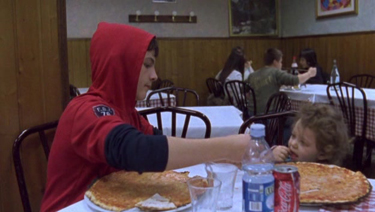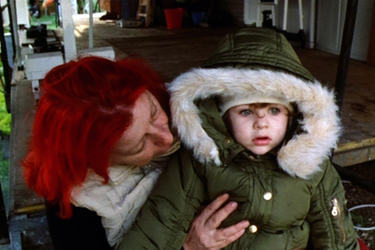Lucidno
 In a very disconcerting ellipse, Patti will off-handedly tell the old man (who is her circus co-performer and possibly also a current or ex-partner) that, at some point in the passage of time traced by this opening sequence, she found a note in Aia's pocket that was clearly written by the child's mother: the unsigned note, she says, reads: "Don't call the police, I'll come back". The logic of the whole film is evident right there: we will have to spend a lot of time looking at Patti walking in the drizzling rain, moving from caravan to caravan, preparing food or ironing clothes or getting her props of sticks and cups ready for a circus performance – but we will never see the conventionally dramatic or revelatory moment, for our own eyes, when she finds this rather significant note in the child's pocket. La Pivellina belongs to a line in contemporary filmmaking that Jacques Aumont describes well in his book Le cinéma et la mise en scène. He calls it a cinema of encounter, in which we are plunged, as spectators, into a world or a situation with little or no background information, no helpful, Hollywood-style backstory exposition or narration.2 In this world as portrayed, we follow characters in their headlong movement – the incessant walking I have mentioned is always a privileged motif – until the moment that they, sometimes literally, collide with someone or something, and from this collision a fictional premise suddenly and (as it were) spontaneously springs. Aumont cites relatively popular examples of the trend, such as the Danish Dogme films of Lars von Trier and the Dardenne brothers in Belgium; but there are many others, including key works within Iranian or Argentinian cinema since the 1990s, or even films which are, in their degrees of formal control, a long way from Dogme – such as the films of Béla Tarr in Hungary or Hou Hsiao-hsien in Taiwan. We could track this movement back in time, too, to the seminal films of Maurice Pialat in the 1960s and '70s for instance, such as Naked-Childhood (1968) or Get Your Diploma First (1979), or the cinema of John Cassavetes – and these are two directors irresistibly and increasingly drawn in their filmmaking careers, in their own extravagant ways, to the motifs of identity loss, downward mobility and economic precarity. Cassavetes' final theatrical production in 1987, for example, concerned a homeless woman, again featuring real circus performers (alongside Gena Rowlands and Carol Kane), which is called A Woman of Mystery. The story of Cornelia Rau with which I began, if written or filmed, could well be titled A Woman of Mystery. How does the politics of this cinematic form – this cinema of encounter that plunges us right into the middle of things – mesh with the politics of subject matter that I have raised here, at a level deeper and more intricate than what can simply be read off the surface of the films, either plainly or allegorically? In asking this, I wish to refocus attention on something that I believe has been a little lost in the forward march of cinema theory these past two decades – namely, what used to be called the place of the spectator.3 Film theory and textual analysis, as well as the most advanced film criticism, for a period in the 1970s and '80s, rested upon a powerful and enabling assumption: that films have the power not merely to engage or bore their spectators, but to position them in a certain way – even if only from the start to the end of a movie. |
Positioning a spectator, is of course, no easy matter – it is not given in advance by the mere fact of having so-called captive spectators in a dark room who have put their hard-earned money down –and its success rate can be loosely measured along a sliding scale from a general or vague orientation of the spectator to a full-blown, hypnotic fixation.Critics such as the great Serge Daney in France in the 1970s and '80s were obsessed with this issue; and, as Daney well saw, many a filmmaker is also obsessed with it, from their own viewpoint: as someone, artist or entertainer or both, who wants to hold the spectator, and moreover (in Daney's phrase) play the spectator as one plays a musical instrument.4 That is the case with Alfred Hitchcock or Brian De Palma, Dario Argento or Fritz Lang – but also far less mainstream figures like Michael Snow, Pedro Costa or Chantal Akerman. In film theory itself, all the heavy 1970s talk of Althusserian interpellation, of suture, of tutor codes and so many other concepts, sprang out of this conviction that films can place their spectators and that therefore, in a dynamic way, also displace, upset, even transform them to some extent. But, in this model, you cannot have the radical displacement without the prior, determining moment of placement or positioning, which is the moment of ideology par excellence. So there was a dynamic and completely, passionately political drama of the subject in process, the spectator pushed and pulled, made and unmade, that inflamed the writings of many film analysts in that '70s period, such as Stephen Heath in his aptly named book Questions of Cinema.5
For many complex (and often good) reasons, subsequent cinema studies, and in particular cultural or media studies, critiqued and abandoned this notion of the placed or positioned spectator. The assumption of an abstract or ideal spectator (who had no particular gender, race or age) was attacked, while the democratic freedom of spectating options open to any of us was stressed. It was, in a way, a blow on behalf of that ordinary, bored, paying spectator – he or she was, after all, no zombie. But this new-found freedom granted, these past two decades, to the active, mobile spectator tends to get rid of not only all the murky complications of the unconscious, and of what Slavoj Žižek today calls the "unknown knowns" of ideology.6 It also completely pulls the rug out from under a certain politics of film and filmmaking. For who on this earth would ever want, for one second, to be a political filmmaker – I mean a real filmmaker, not a propagandist or a facile, didactic storyteller like Michael Winterbottom – if he or she did not believe, profoundly, that a film can really get in and mess with a spectator's head and heart? For that to happen – for there to be any chance of it happening – you need, precisely, the place of the spectator and everything it opens as a field of work, play and experimentation. You need the laboratory, the worksite-in-progress, of the spectator – who does not come in fully formed, or entirely with a mastery of their conscious self, and who experiences something difficult and desirable in their own encounter with the film as an unfolding event.  |

